

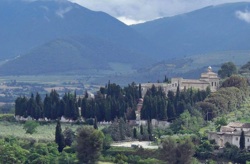
San Salvatore stands on the site of an early Christian cemetery: an inscription (5th century) from the grave of someone called Felicissimus was discovered under the door on the right in ca. 1960. [Where is it now ?] The present municipal cemetery (surrounded by cypress trees) is next to the church. (For the historical background, see the page on Early Christianity in Spoleto).
Until the 19th century, many scholars believed that the east end of this ancient church had been adapted from a pagan temple and that its nave and aisles had been added in the early Christian period. However, Giuseppe Sordini's excavations in 1906-7 revealed that the east end and the facade were in fact from the same building, albeit that the intervening nave and aisles had subsequently collapsed and been rebuilt. The iconography of many of the architectural elements that were integral to this building proved that it had been purpose-built as a Christian place of worship.
The earliest secure reference to the church dates to 1064, when it was referred to as the "monasterium sancti concordi" (i.e. it was a nunnery dedicated to St Concordius). It was later recorded with an additional dedication to St Senzius and indeed the first church here might have been built on the presumed site of his burial in the 5th century. There is no secure basis for dating the current building, although it might well date to the Lombard period.
The church and adjacent buildings belonged to a series of religious communities:
-
✴The nuns who were here from at least 1064 do not seem to have belonged to a particular order. In 1235, Pope Gregory IX tried to impose on them the form of life that he had devised for female communities, and when they resisted he suppressed the nunnery and moved the nuns to San Tommaso.
-
✴A community of male Augustinian hermits settled here soon after. In 1263, Bishop Bartolomeo Accorambi gave them a church inside the city walls. Many of hermits subsequently moved to what became the convent of San Nicolò.
-
✴In 1285, Bishop Rolando authorised a community of women who had agreed with their husbands to lead separate religious lives to settle at San Concordio. This community was badly affected by wars and “other calamities” and Pope Martin V suppressed it in 1424. the remaining nuns transfered to Santa Maria della Stella.
-
✴In 1456, the complex passed to a community of Servite tertiaries, but they moved to Santa Trinità three years later.
-
✴In 1624, San Concordio passed to an order of reformed Augustinian canons.
At the time of this last transfer, the church was known as "sanctorum concordii et sentii nuncupata il Crucifisso" (SS Concordio e Senzia, known as SS Crocifisso). It retained this dedication until 1860, when Father Bonaventura Viani identified it with the "monasterium sanctii salvatoris", a monastery near Spoleto that the Emperor Louis the Pious had confirmed as a possession of the Abbazia di Farfa in 815. This hypothesis was broadly accepted and the church subsequently became known as San Salvatore, although modern scholarship suggests that the original San Salvatore was in fact a different church.
The church was de-consecrated in the 19th century and Giuseppe Sordini restored it in 1906.
Exterior
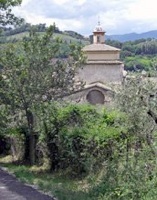
This lovely view of the east end of the church and its lantern (see below) is taken from the lane to the side.
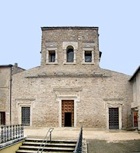
-
✴The upper order is the width of the nave within. The bases of four pilasters that originally articulated it can still be seen above the cornice. Each of its three windows has elaborate columns to the sides:
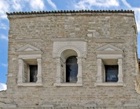
-
•The two outer windows have Classical entablatures and triangular pediments.
-
•The central window is extremely unusual and betrays eastern influence.
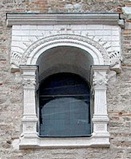
-
✴The lower order has three portals, each of which has a carved lintel with a cross among acanthus leaves. The central portal is particularly fine. (Its architrave provided the inspiration for the architrave (13th century) of the Duomo).
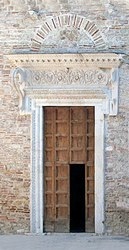
Interior
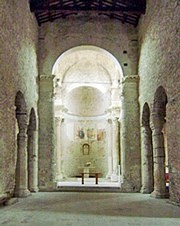
The interior is in the form of a high nave and two lower aisles. Steps in the nave lead up to the presbytery. Giant columns at its corners support an octagonal drum and dome, the lantern of which was added in the 18th century. The east end of the church survives in essentially its original form:
-
✴The nave culminates in a semicircular apse, which retains part of its original pavement.
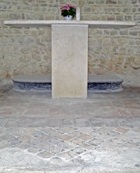
-
✴The aisles culminate in tall square chapels that are deeper than the apse, which are reminiscent of the pastophoria that flank the apse in some Byzantine churches.
The colonnades that separated the nave from the aisles collapsed at a relatively early date and have been crudely replaced by walls, each of which has a series of arched openings.
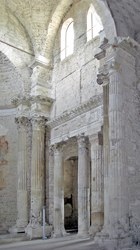
-
✴an order of columns at ground level supporting a carved frieze;
-
✴an order of pilasters above; and
-
✴a clerestory (alternating windows and columns) above that.
Two square-sectioned capitals clearly originally belonged to square-sectioned pilasters, perhaps those that were originally on the facade (see above):
-
✴that of the 3rd column from the left in the colonade to the right of the presbytery; and
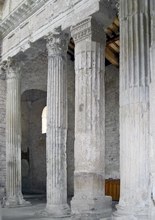
-
✴that of the last column on the right in the nave.
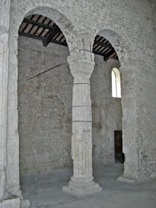
They inspired the capitals in an aedicule painted in the fresco (ca. 1466) of the Annunciation by Filippo Lippi in the apse of the Duomo.
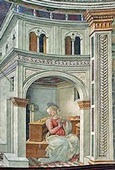
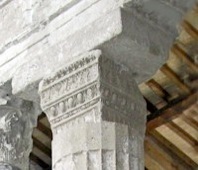
Crucifix (8th century ?)
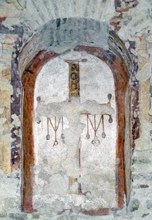
Frescoes in the apse (16th century)
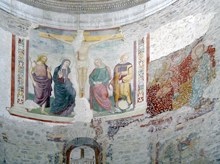
Two damaged frescoes survive high up in the apse:
-
✴the Crucifixion with
-
•St John the Baptist and the Virgin on the left; and,
-
•SS John the Evangelist and Senzius (who spears a green dragon) on the right,
-
which is attributed to Bernardino Mezzastris; and
-
✴the Madonna and Child with an unidentifiable saint.
Frescoes (1478)
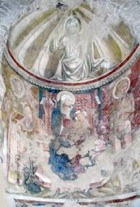
-
✴God the Father (above); and
-
✴the Madonna and Child with SS Senzius (with a dragon) early 14th century)and Sebastian.
Frescoes (15th century)
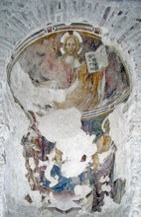
Deacon saints (early 14th century)
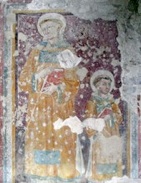
Art from the Church
Crucifixion (14th century)
This fresco of the Crucifixion with the Virgin and St John the Evangelist was recorded in the 16th century, when it was already detached and placed above the high altar. When this altar was destroyed in the re-modeling of 1906, the fresco was moved to right wall. It was stolen in 1980 but recovered in 1983, after which it was restored. [Where is it now ??]

